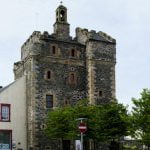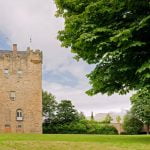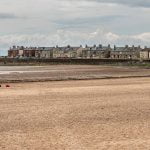The Five Minutes Spare Guide to Cowdenbeath
Fife’s best kept secret until Queen Victoria arrived.
A former coaching stop on the road up to Perth, Cowdenbeath shot to success in the 1820s. However, we know from our other Scottish town guides that the regions have a far longer history than most initial thumbs through the history let on.
We explored Cowdenbeath in as great a detail as we were brave enough to go to. Find out if it is the kind of place, you would like to visit by reading another of our exemplary town guides.
Early History of Cowdenbeath
There is not a lot of evidence for an early settlement in Cowdenbeath. However. Late Bronze Age vessels have been discovered in the area. In 1928, renowned archaeologist A D Lacaille F S A Scott detailed these late Bronze Age artefacts. He reported the discovery of a Bronze Age cemetery near Tollie Hill. One of the urns that they found contained Arran pitchstone, which is a very interesting occurrence. Arran Pitchstone as the closest thing that the Scottish lands give you to Obsidian.
There is only one place in Scotland that you can find it and that is on the Isle of Arran – specifically just off the coast of the Isle of Arran. Now the Isle of Arran is in the opposite end of the country from Fife. Archaeologists believe that the presence of Arran Pitchstone in these burial vases means that there must have been significant economic activity in the area. It was quite a find.
Even with the evidence of economic activity, there is little evidence of an early settlement. We are not 100% sure which clan would have owned these lands before the town became a town. We have narrowed it down to two choices. Clan Wemyss owned nearby Wemyss Bay and the castle there was known as castle Wemyss.
On the other hand, clan MacDuff were the overlords of Fife. The clan Macduff may well have owned the lands of Cowdenbeath. This would tie in with the prominence of Clan Macduff in the 14th and 15th centuries. In the 1400s, locals added a parish church to the area. This was when Clan Macduff were at their strongest.
The Medieval Years
As we mentioned, a parish church appeared in the 1200s. The MacDuff’s fought in the 1306 wars of Independence. As an interesting side note, the clan are an Armigerous clan. This means that their last chief died, and nobody replaced him and that they are also old enough to be registered with the Lyon Court. This register of Scots clans and arms began in 1692.
Clan MacDuff comes down the lines from Queen Gruoch of Scotland – that actual MacBeth’s wife. Malcolm III of Scotland seized power from MacBeth, and their early chiefs were the Earls and Dukes of Fife. They were once known as the premier Gaels, although they were a lowland clan, and we know a few highlanders who would take Umbridge at this.
Back to the town, Cowdenbeath residents established Beath Kirk in 1430. The earliest known recording of a settlement in the area was in 1178 when a charter refers to a chapel at Beath. The word ‘Beath’ in Scots Gaelic means ‘Birch.’ It was not until 1643 that the Reverend John Row of Carnock decided to split the church apart and make it an individual parish from the towns at Dalgety Bay and Aberdour. Locals built a new church in 1640 to his specifications. By that time, records noted that the old parish church had fallen to ruin. The church that stands today was built in the 1800s and has been since refurbished.
By the 1600s the name Cowdenbeath had come into use, though we are not sure how. An inn stood here at a crossroads. The crossroads was known as the BaitheMoubray alias Cowdounes-Baithe and belonged to a man named Willielmus Walker. A 1654 map by a Dutch cartographer records the use of Cowden Beth.
Let us stop there and move on to a few fun facts from the area. Next up is the tale of how Burke and Hare have a history here.
Fun Trivia About Cowdenbeath
We like to dish the dirt on all the towns we review. Here is all the gossip we could scoop up about Cowdenbeath in trivia form:
- Cowdenbeath is locally renowned for being home to Mossmorran, the oil refinery found on the A92.
- Cowdenbeath grew from 1,000 people to 25,000 people between 1850 and 1914 thanks to Queen Victoria passing through. It grew so quickly that people started calling it the Chicago of Fife.
- Cowdenbeath Football Club earned the nickname The Blue Brazil,
- There were as many as fifty coal pits in the area during the Industrial period. Fife was an important source of coal for the rest of Scotland, especially those towns to the north.
- Fife was home to the Fife School of Mining from 1895 to 1910.
- Due to extensive mining underneath Cowdenbeath, there have been some subsidence issues over the years. The ground we walk on is not as hardy as it may seem. It is described as a town where buildings tilt and lean!
- The town went into an economic recession after the height of the coal rush. By the seventy’s only two pits remained. Two pits and a lot of disgruntled former workers.
Cowdenbeath has been a hugely successful town over the years, just as it has had its moments of depression. Let us get back to that history and finish off finding out what made Cowdenbeath the way it is now.
The Industrial Era
In 1790 there were one hundred families in Cowdenbeath, making it a larger than average rural settlement. In the early 1800s, Burke and Hare – two notorious Scots – were rumoured to have been active in the area. Burke and Hare are famous for sourcing corpses for the medical students studying in the University in Edinburgh. Medical students need cadavers to study on, and particularly so back then, when not as much was known about anatomy as we know now. Burke and Hare were corpse sellers, except that they could not keep up with demand.
They began to steal fresh corpses from cemeteries by digging them up. When the people of Edinburgh caught on to what they were doing, they started ordering burial mounds with great iron bars across the top to keep out the grave robbers. Later, the two evil men would solve this problem by killing people themselves and selling on the bodies.
There is a specific technique for murdering someone that is known as the Burke and Hare, or the Burke. The killer holds the victim’s mouth shut – usually an elderly or weakened person who could not fight back. While holding the mouth under the chin, they would pinch the nose with the same hand. This one-handed murder technique is known throughout Scotland to this day. Visitors to Edinburgh see the iron grates over graves and often assume the people feared vampires.
They did not. They feared their bodies ending up with medical students. Wealthy families also placed guards in tombs to watch their dead loved ones. Burke and Hare were finally caught after selling the body of Burke’s own wife. They made about £7 a body. We know that they killed at least 16 people, but the true number might be closer to 30.
What is all this got to do with Cowdenbeath? When bodies went missing from a graveyard situated outside of town, the town was a victim. Locals placed a large flat stone over the graves and iron coffins were lowered on top of graves to stop future thefts.
Queen Victoria Pays a Visit
In 1820 Queen Victoria passed through on her way north. She stopped at the Coaching Inn to change horses. Later, a turnpike added in the same place made the town extra important. Up until 1850, the town was four large farming communities. After word spread that Queen Victoria had not hated it there, it grew in popularity. This was the same time that miners realised there was coal under the town and shafts dugout. This attracted even more workers. There were smaller pits too, but these stopped mining coal as early as the 1870s.
By 1860 the Forth Iron Company had moved in and amalgamated with the Cowdenbeath Coal Company. Between 1890 and 1900 the population doubled from 4k to 8k. The football club opened in 1881 and the town became a burgh in 1890, but this was abolished in 1975.
Modern Day Cowdenbeath
There is a Scottish sport we do not talk about that was incredibly popular in the 1900s, and that’s bools (bowling). While European bowling is played on sand and contestants toss the ball to be closest to the small white ball, the Scots version is more like bowling in an alley. You roll the balls towards the white ones and, much like in curling, the closest wins. Cowdenbeath has had their own bowling club since 1903. In 1905, the football team joined the Scottish League.
By 1909 Cowdenbeath had an electric tram service, and in 1910 the Beath Higher Grade School opened. In 1910, the Fife School of Mining moved here after subsidence threatened to topple it. Just prior to WWI, the population was 14,029. By 1950 it had dropped to 13,151. The pits closed in the 1960s. marking a further period of decline. Beath High School moved in 1964 and Cowdenbeath Golf Club opened in 1991. It was extended to eighteen holes in 1996[i].
Let us not skip past those war years because everyone in Scotland was affected by them. There are 264 names on the memorial that served in WWI, with a further 245 names added after WWII. The townsfolk cleaned up the memorial obelisk in 1949.
As of 2001, the population of Cowdenbeath was 11,27, so still falling. Kirkcaldy and Cowdenbeath were made into a constituency in time for the 2005 election.
Modern day Cowdenbeath retains the air of an industrial town. There are signs of coal mining for miles in either direction. Although the town is smaller, it is a determined little place. The people that come from it love it dearly and remember the plight of the mines closing under Thatcher with horrible distaste.
Famous People from Cowdenbeath/Fife
We like to dig the dirt on famous faces that you might meet in town while you are visiting. Cowdenbeath is a small place, so we opened it up to the rest of Fife. Let us see who Fife’s famous faces are:
- A number of footballers, including Jimmy Allan, George Bissett, Bobby Bauld, Ray Allan, Tommy Callaghan, Willie Callaghan, and countless others.
- Famous communist Mary Docherty.
- Donald Findlay, who is the Queen’s Counsel in Scotland.
- Tom Gourdie the Calligrapher and artist.
- Tom Kellichan, drummer for the Skids.
As you can see, lots of footballers. Scotland has a thing about growing up to be a footballer. For such a small country, we have many football stars. Let us skip on to the part you have all been waiting for… the attractions in this Fife town.
Top Attractions in Cowdenbeath
We would not be us if we did not bring you our favourite attraction in the town we were reviewing. Here are the best things to see in do in Cowdenbeath… we would want to let you down.
Historic Sights and Landmarks
The Jim Baxter memorial statue in Cowdenbeath is a point of local interest. It serves as a landmark and commemorates the footballer in mid-stride as he kicks a ball. You will find the statue outside the Hill of Beath Primary School. This is quite close to the Hill of Beath Hawthorn FC Park. Jim Baxter played for Rangers FC and many fans still regard him as the greatest player on the team. He also played for Scotland, which makes him loved on a national level.
Take the trip to the memorial for the Donibristle Mining Disaster. This accident occurred in 1901 in the Donibristle Colliery. Men working on a shaft found soft peat and moss started flowing in and flooding the shaft. Four men died in the initial flow of moss. Two teams went down to rescue them. One of those teams were never seen again. The other team managed to rescue five men. However, that party of six were never found. Their bodies are still down there, under the feet of the people of Cowdenbeath and buried in moss. The whole incident was horrible if fascinating for historical reference on how the mines worked.
The townsfolk called in the mine overseer, who travelled to the mine immediately and wrote a report. Rescuers found two of the recovered bodies in the moss, one as far as 105 yards away from the worst of the flow. Another died in a refuge hole, due to suffocation. The rescued men were in the hole for up to 32 hours, though the overseer notes that they had already worked a 7-hour shift before the infill. They held an inquest, and the jury was satisfied that it was a freak accident. Moss should not be fluid. You can read the report here or visit the stone that commemorates the loss.
Galleries and Museums
Cowdenbeath is not particularly cultural because it does not have that strong sense of identity that towns of ancient origins have. What it does have, are plenty of statues and plenty of churches. If you are inclined, stop by Our Lady 0f St Brides Parish Church, check out the Beath and Cowdenbeath North Church, the Baptist Church, or the Cowdenbeath Trinity Church. It is the one town in Scotland to match the number of churches with the number of places to get drunk. We are not sure that the two are related.
If you must have a gallery on your holiday, then have no fear. Cowdenbeath is bang-slap in the middle of Fife. So, you have any art galleries in Dunfermline to visit, and there are the Kirkcaldy galleries, too. You can even keep going north to Perth if you like. We recommend the Quay Gallery on Burntisland, which is the closest.
The nearest cool museum is to your west, away from that gorgeous coastline. Head to the Lathalmond Railway Museum to see some steam trains and learn about signal towers. This was once a Royal Naval store depot, so it has an excellent collection of navy based trains. The West of Fife Munitions Railway runs through it and would have seen use in WWII transporting weaponry. Also known as Shed 47, the railway closed in 1971 and the depot closed in 1993. This place was seeing use right up until then.
Outdoor Attractions
If you want good outdoor attractions, you really need to head east out of town and towards that lovely coastline. Visit Castle MacDuff, which is a bit ruined but still cool. You can head to the seaside and visit Leven beach, a gorgeous strip of sandy goodness perfect for hot summer days.
You can head to Venters Park for a long walk with the dog, too. This is a large area of flat playing fields that you can catch players on, or just use to sunbathe. There is a Little World of Play to the north of town that the kids love.
Sports and Recreation
You can visit the local football team in Central Park, central to the town. This area used to be dominated by coal pits and now has a football stadium on it. It provides partial cover from the rain with some sheltered seating. It is a big park; the team have been in the football leagues in Scotland since the early 1900s. It is the official grounds for Cowdenbeath FC, but is also sometimes used for stock car racing, too.
This brings us to the Cowdenbeath Racewall. This sporting group run events every week at the stadium. Racers pit stock cars of all descriptions against each other for fun. You can witness everything from hot rod cars to classic saloons. The action is exactly as exciting as you would expect, and the crowd are mostly drunk if not all. It is a great atmosphere. Arrive early to take part in the pre-race-drinking.
If you need a gym while you are in the area, you can attend the Cowdenbeath Leisure Centre. They have a swimming pool, a sports hall you can rent, they run five-a-side games, and even have an auditorium which can double as a theatre. There is also an old bingo hall in town, but you would have to toss a coin to see if they made it through the pandemic.
Shopping and Retail
Really, you are only five miles from Dunfermline. Why would you want to shop here? They have a B & M though, so they have taken care of the important things.
Other Notable Attractions in Cowdenbeath
If you have made it this far, you are staying in Fife for a few weeks. In that case, here are a few other nearby sights to see.
- Check out Adventure Golf Island towards Dunfermline, and do not forget that Cowdenbeath has its own golf club, too.
- Head down to Silver Sands Beach in Aberdour, which is exactly as pretty as it sounds.
- Alternatively, go to the beach at Burntisland. We warn you though, the Scots flock here in warm weather.
- Visit Ravenscraig Castle in Kirkcaldy.
How to Get to Cowdenbeath
This small Fife town is only five miles northeast of Dunfermline. You would think this would make it easy to get to but use our directions and you might still get lost.
By Road
Head up the A92 out of Dunfermline.
By Rail
Aim for Cowdenbeath Train Station.
By Air
Flying into Edinburgh Airport is the quickest option.
By Sea
You are landlocked but Fife is coast so just head east.
Still On Your Break?
If you still have a spare five minutes, we are the people you need in your life. Head to the Five Minutes Spare Facebook page
[i] http://www.visitoruk.com/Cowdenbeath/21st-century-T3425.html





